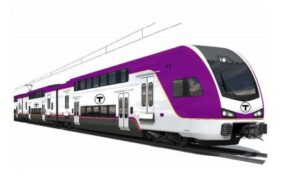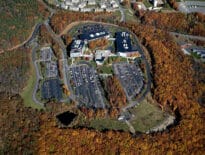
A concept for an electrified MBTA commuter rail train from rail manufacturer Stadler. Image courtesy of the MBTA
The MBTA should focus its initial efforts to transform its commuter rail network on lines that connect Downtown Boston, Beverly, Providence and Mattapan, a prominent transit advocacy group says.
Transit Matters laid out a $2.62 billion proposal in a webinar Monday morning, which the group said could achieve frequent, fast, electrified service on the Providence/Stoughton and Fairmount commuter rail lines, as well as on the Newburyport/Rockport line up to Beverly, by 2030. The proposal, described in a technical report released at the same time, adds significant details outlining how the MBTA could act on a fall 2019 directive from its oversight board to transform the commuter rail system into service that provided frequent, all-day service like a subway system. The MBTA has issued a request for information from electric train manufacturers, but has not publicly outlined how it would implement the directive.
“This is not something that’s way out in the future. We can start moving towards it this year,” Transit Matters COO Jared Johnson said.
The T’s current commuter rail service is structured and priced primarily to move office workers from suburban bedroom communities to jobs in the downtown core in the morning and back out again in the evening, with significant gaps in the middle of the day and in reverse-direction service. By filling those gaps and making trains more frequent, Transit Matters says the state can reduce its greenhouse gas emissions by taking cars off the road, can reduce congestion in Boston’s suburbs by giving a more reliable way to travel between towns and can unlock housing and office development opportunities in the suburbs as some companies and residents look to relocate out of the region’s urban core. The group points to the success similar systems, known as “regional rail” systems, have had in other countries.
“We really need regional rail now,” said Transit Matters board member and MassINC transit-oriented development fellow Tracy Corley. “It allows for more mobility in our regions. Not just getting into downtown Boston but so folks in those communities along those lines can travel between them.”
“It’s really hard to rely on public transit [in the suburbs]. It really over-congests our roads, ”
The core of the work involves adding high-level platforms to stations along the three lines it singled out among the 12 that make up the network, removing bottlenecks like stretches of single track like the tunnel underneath downtown Salem and electrifying the tracks to Stoughton, Mattapan and Beverly, Transit Matters said. The line to Providence has been electrified for some years in order to support Amtrak service. Taken together, the improvements would allow the MTBA to run trains every 15 minutes on all lines and every 30-60 minutes on all other lines by 2025, and clearing the biggest obstacles for incrementally transforming all lines in the system at a later date.
Johnson acknowledged that while some portions of Transit Matters’ proposal are already funded by federal grants and state spending plans, but much of it would have to be paid for with new money from the legislature.
“Certainly it isn’t going to be easy to find $2.3 billion under couch cushions,” he said, but argued that Massachusetts will never be able to support more housing construction, curb congestion, meet greenhouse gas reduction targets or eliminate air pollution hazards that plague cities like Chelsea, Lynn and Brockton without finding ways to move people more efficiently around Greater Boston’s suburbs.
The demand for suburban office space appears to be strengthening in the wake of the pandemic, suburban landlord Cummings Properties President Eric Anderson told Banker & Tradesman in an interview. The company owns and manages over 10 million square feet of commercial real estate in 11 communities north of Boston.
“I’ve been pretty encouraged by the amount of new business I’m seeing,” he said. “The fact that May was busier than January is notable…we’re a good bit ahead of where we were last year, too. If we see a big drop-off in June that will suggest it was pent-up demand rather than a shift or something other than the pent-up demand”
With the pandemic putting pressure on many companies’ bottom lines and a need to spread desks further apart, he said, some downtown firms whose leases expire soon are researching relocations to suburban office or flex space. Demand will likely ramp up in the next six to 12 months, he said.
The company is confident enough in demand that it decided, mid-pandemic, to begin work on a pair of speculative flex-office buildings in the northern suburbs of Boston.






